We’ve reached a critical moment in U.S. national security with kinetic and geopolitical conflicts that are knocking at the doors of global superpowers and smaller nations alike.
In the 21st century, the era of technology has ushered in a new way of fighting with drones and long-range missiles and hypersonics. In the near future, it may not be American soldiers leading from the front line but an array of autonomous and technologically advanced weapons defending us.
Furthermore, this new era of technology and warfare has decreased the cost associated with developing and deploying modernized airborne threats. Advanced radar capabilities are, therefore, needed to detect, identify, and engage both small and large, more lethal threats. Investing in these advanced radar capabilities is vital to our national security efforts – and the sooner the better.
As global warfare evolves to a more technologically advanced battlefield, the U.S. must design and deploy innovative solutions to bolster its defensive capabilities. The complexity and frequency of airborne threats underscore the necessity of innovative defense.
The ongoing conflict in Ukraine and the recent Iranian attack on Israel highlight the urgency. Investing in and developing advanced radars allows the U.S. to bolster its defense against airborne threats. Our ability to detect, identify and engage threats is paramount. As long as an airborne threat – from a hypersonic missile to a suspicious spy balloon – can be detected, it can be intercepted.
Increasing radar coverage along borders and across the homeland is critical. The radar space can be overcrowded, and equipment expensive. Creating more innovative and cost-effective radar solutions is the best way to detect, identify and track the multitude of airborne objects proliferating our skies like the 2023 Chinese balloon incident, which captured the attention of the nation.
What we are seeing on the front pages of the news is the new reality. Since the Russian invasion of Ukraine, we have been able to see new tactics, including drone swarms that overwhelm sensors and defenses to cause grave harm with smaller tactical devices. The ability to track these faster and more lethal airborne objects is incredibly challenging and takes sophisticated systems engineering.
Our adversaries can produce these more lethal projectiles more rapidly and cost-effectively and continue to bombard legacy defense systems and deplete our stockpiles of exquisite weapons and interceptors.
To counter this new threat reality, we must develop and deploy more advanced sensors in a rapid and more cost-effective manner. Developing and updating radars allows the U.S. military and our allies to better detect and, ultimately, defend against new threats.
Legacy radars of the kind many are familiar when driving by a local airport were designed over 50 years ago and are ill-equipped to detect threats. Today, we can update radars using a modernized design that utilizes hundreds of tiny antennas to deliver a more powerful picture of objects in the sky. These updated radars can detect multiple threats from multiple directions at one time by electronically scanning the entire sky.
The data detected from these radars would then be transferred and integrated into the systems that intercept these aerial threats. Deploying hundreds of state-of-the-art radars providing dense and low-altitude coverage with intercept-quality accuracies against new and emerging threats will enhance national security.
This approach could not come at a more opportune time. Our adversaries are watching the same news reports, increasing production and developing new tactics and ways to inflict more harm with faster, more lethal, more autonomous, more jamming-proof and harder-to-detect drones. The U.S. military is a highly capable force of protecting Americans from bad actors. It’ time we ensure our military and our allies have the tools to better defend and protect us.
The arena of warfare will continue to be more complex as technology continues to evolve and our national defense strategies and technology must be able to stay one step ahead. The U.S. has proven to be an incubator for cutting-edge research and development over our history. By embracing innovation and adaptability, the U.S. can mitigate the risk posed by airborne threats, guard our national security interests and promote peace in a hostile and complex global landscape.
Dmitry Turbiner is the Founder and CEO of General Radar whose mission is to build the World’s first 100% commercial AESA radar with flagship DoD performance. General Radar has secured over $35M in venture capital investment and is executing on several DoD and commercial contracts. Prior to General Radar, Dmitry was an RF and Antenna Engineer at NASA/JPL where he served as the Cognizant Engineer for the COSMIC-2/FORMOSAT-7 Mission’s Radio Occultation Antenna Array. Twelve of Dmitry’s phased array antennas are orbiting on a constellation of six heavy NASA satellites.








